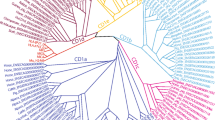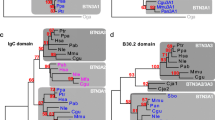Abstract
Butyrophilins (BTN) belong to the immunoglobulin (Ig) superfamily of transmembrane proteins. These molecules are of increasing interest to immunologists, as they share a structural homology with B7 family members at the extracellular domain level. Moreover, a role of these molecules has been suggested in the negative regulation of lymphocyte activation for almost all the BTN that have been studied. In addition, the expression of some BTN family members has been reported to be associated with autoimmune diseases. Over the last few years, the number of BTN and BTN-like members has greatly increased. In this study, the butyrophilin family in mammals has been revisited, using phylogenetic analysis to identify all the family members and the phylogenetic relations among them, and to establish a standard nomenclature. Fourteen BTN groups were identified that are not all conserved between mammalian species. In addition, an overview of expression profiles and functional BTN data demonstrates that these molecules represent a new area of investigation for the design of future strategies in the modulation of the immune system.





Similar content being viewed by others
References
Amadou C, Ribouchon MT, Mattei MG, Jenkins NA, Gilbert DJ, Copeland NG, Avoustin P, Pontarotti P (1995) Localization of new genes and markers to the distal part of the human major histocompatibility complex (MHC) region and comparison with the mouse: new insights into the evolution of mammalian genomes. Genomics 26:9–20
Arnett HA, Escobar SS, Gonzalez-Suarez E, Budelsky AL, Steffen LA, Boiani N, Zhang M, Siu G, Brewer AW, Viney JL (2007) BTNL2, a butyrophilin/B7-like molecule, is a negative costimulatory molecule modulated in intestinal Inflammation. J Immunol 178:1523–1533
Arnett HA, Escobara SS, Viney JL (2009) Regulation of costimulation in the era of butyrophilins. Cytokine 46:370–375
Ballenthin PA, Gardinier MV (1996) Myelin/oligodendrocyte glycoprotein is alternatively spliced in humans but not mice. J Neurosci Res 46:271–281
Bas A, Swamy M, Abeler-Dörner L, Williams G, Pang DJ, Barbee SD, Hayday AC (2011) Butyrophilin-like 1 encodes an enterocyte protein that selectively regulates functional interactions with T lymphocytes. Proc Natl Acad Sci USA 108:4376–4381
Boyden LM, Lewis JM, Barbee SD, Bas A, Girardi M, Hayday AC, Tigelaar RE, Lifton RP (2008) Skint1, the prototype of a newly identified immunoglobulin superfamily gene cluster, positively selects epidermal gammadelta T cells. Nat Genet 40:656–662
Boyle LH, Traherne JA, Plotnek G, Ward R, Trowsdale J (2007) Splice variation in the cytoplasmic domains of myelin oligodendrocyte glycoprotein affects its cellular localisation and transport. J Neurochem 102:1853–1862
Compte C, Pontarotti P, Collette Y, Lopez M, Olive D (2004) Characterization of BT3 molecules belonging to the B7 family expressed on immune cells. Eur J Immunol 34:2089–2099
Cong H, Jiang Y, Tien T (2011) Identification of the myelin oligodendrocyte glycoprotein as a cellular receptor for rubella virus. J Virol 85:11038–11047
Cubillos-Ruiz JR, Conejo-Garcia JR (2011) Potential role of butyrophilins in inhibiting anti-tumor immune responses. Cell Cycle 10:368–369
Franke WW, Heid HW, Grund C, Winter S, Freudenstein C, Schmid E, Jarasch ED, Keenan TW (1981) Antibodies to the major insoluble milk fat globule membrane-associated protein: specific location in apical regions of lactating epithelial cells. J Cell Biol 89:485–494
Frisch C, Kolmar H, Schmidt A, Kleemann G, Reinhardt A, Pohl E, Usón I, Schneider TR, Fritz HJ (1996) Contribution of the intramolecular disulfide bridge to the folding stability of REIv, the variable domain of a human immunoglobulin κ light chain. Fold Des 1:431–440
Geijtenbeek TB, van Kooyk Y (2003) Pathogens target DC-SIGN to influence their fate DC-SIGN functions as a pathogen receptor with broad specificity. APMIS 111:698–714
Greenwald RJ, Freeman GJ, Sharpe AH (2005) The B7 family revisited. Annu Rev Immunol 23:515–548
He XR, He YY, Chen Y, Ye TZ (2006) Expression of human ERMAP gene in fetal tissues. Zhongguo Shi Yan Xue Ye Xue Za Zhi 14:972–975
Ikemizu S, Gilbert RJ, Fennelly JA, Collins AV, Harlos K, Jones EY, Stuart DI, Davis SJ (2000) Structure and dimerization of a soluble form of B7-1. Immunity 12:51–60
Jeong J, Rao AU, Xu J, Ogg SL, Hathout Y, Fenselau C, Mather IH (2009) The PRY/SPRY/B30.2 domain of butyrophilin 1A1 (BTN1A1) binds to xanthine oxidoreductase: implications for the function of BTN1A1 in the mammary gland and other tissues. J Biol Chem 284:22444–22456
Johns GT, Bernard CCA (1999) The structure and function of myelin oligodendrocyte glycoprotein. J Neurochem 72:1–9
Lin LD, He XR, Ye TZ, He YY, Guan JM, Chen Y, Liang JF (2008) Expression of human ermap gene in umbilical cord blood mononuclear cells during differentiation and development towards erythroid lineage. Zhongguo Shi Yan Xue Ye Xue Za Zhi 16:328–332
Linington C, Webb M, Woodhams PL (1984) A novel myelin associated glycoprotein defined by a mouse monoclonal antibody. Neuroimmunol 6:387–396
Linsley PS, Peach R, Gladstone P, Bajorath J (1994) Extending the B7 (CD80) gene family. Protein Sci 3:1341–1343
Malcherek G, Mayr L, Roda-Navarro P, Rhodes D, Miller N, Trowsdale J (2007) The B7 homolog butyrophilin BTN2A1 is a novel ligand for DC-SIGN. J Immunol 179:3804–3811
Messal N, Mamessier E, Sylvain A, Celis-Gutierrez J, Thibult ML, Chetaille B, Firaguay G, Pastor S, Guillaume Y, Wang Q, Hirsch I, Nunès JA, Olive D (2011) Differential role for CD277 as co-regulator of the immune signal in T and NK cells. Eur J Immunol 41:3443–3454
Ogg SL, Weldon AK, Dobbie L, Smith AJ, Mather IH (2004) Expression of butyrophilin (Btn1a1) in lactating mammary gland is essential for the regulated secretion of milk-lipid droplets. Proc Natl Acad Sci USA 101:10084–10089
Opazo JC, Hoffmann FG, Storz JF (2008) Differential loss of embryonic globin genes during the radiation of placental mammals. Proc Natl Acad Sci USA 105:12950–12955
Pham-Dinh D, Mattei MG, Nussbaum JL, Roussel G, Pontarotti P, Roeckel N, Mather IH, Artzt K, Lindahl KF, Dautigny A (1993) Myelin/oligodendrocyte glycoprotein is a member of a subset of the immunoglobulin superfamily encoded within the major histocompatibility complex. Proc Natl Acad Sci USA 90:7990–7994
Price P, Santoso L, Mastaglia F, Garlepp M, Kok CC, Allcock R, Laing N (2004) Two major histocompatibility complex haplotypes influence sus-ceptibility to sporadic inclusion body myositis: critical evaluation of an association with HLA-DR3. Tissue Antigens 64:575–580
Rascol VL, Levasseur A, Chabrol O et al (2009) CASSIOPE: an expert system for conserved regions searches. BMC Bioinformatics 10:284
Rhodes DA, Stammers M, Malcherek G, Beck S, Trowsdale J (2001) The cluster of BTN genes in the extended major histocompatibility complex. Genomics 71:351–362
Rybicki BA, Walewski JL, Maliarik MJ, Kian H, Iannuzzi MC (2005) The BTNL2 gene and sarcoidosis susceptibility in African Americans and Whites. Am J Hum Genet 77:491–499
Scannell DR, Byrne KP, Gordon JL, Wong S, Wolfe KH (2006) Multiple rounds of speciation associated with reciprocal gene loss in polyploid yeasts. Nature 440:341–345
Simone R, Barbarat B, Rabellino A, Icardi G, Bagnasco M, Pesce G, Olive D, Saverino D (2010) Ligation of the BT3 molecules, members of the B7 family, enhance the proinflammatory responses of human monocytes and monocyte-derived dendritic cells. Mol Immunol 48:109–118
Slavin A, Johns GT, Orian J, Bernard CCA (1997) Regulation of myelin oligodendrocyte glycoprotein in different species throughout development. Dev Neurosci 19:69–78
Smith IA, Knezevic BR, Ammann JU, Rhodes DA, Aw D, Palmer DB, Mather IH, Trowsdale J (2010) BTN1A1, the mammary gland butyrophilin, and BTN2A2 are both inhibitors of T cell activation. J Immunol 184:3514–3525
Stammers M, Rowen L, Rhodes D, Trowsdale J, Beck S (2000) BTL-II: a polymorphic locus with homology to the butyrophilin gene family, located at the border of the major histocompatibility complex class II and class III regions in human and mouse. Immunogenetics 51:373–382
Su YY, Gordon CT, Ye TZ, Perkins AC, Chui DHK (2001) Human ERMAP: an erythroid adhesion/receptor transmembrane protein. Blood Cells Mol Dis 27:938–949
Tazi-Ahnini R, Henry J, Offer C, Bouissou-Bouchouata C, Mather IH, Pontarotti P (1997) Cloning, localization, and structure of new members of the butyrophilin gene family in the juxta-telomeric region of the major histocompatibility complex. Immunogenetics 47:55–63
Yamashiro H, Yoshizaki S, Tadaki T, Egawa K, Seo N (2010) Stimulation of human butyrophilin 3 molecules results in negative regulation of cellular immunity. J Leukoc Biol 88:757–767
Yamazaki T, Goya I, Graf D, Craig S, Martin-Orozco N, Cl D (2010) A butyrophilin family member critically inhibits T cell activation. J Immunol 185:5907–5914
Ye TZ, Gordon CT, Lai YH, Fujiwara Y, Peters LL, Perkins AC, Chui DH (2000) Ermap, a gene coding for a novel erythroid specific adhesion/receptor membrane protein. Gene 242:337–345
Acknowledgments
We thank the Evolutionary Biology and Modeling laboratory members for technical assistance. We thank Dr. Jacques Nunès for manuscript correction. This work was supported by ANR grant EVOLHHUPRO no. ANR-07-BLAN-0054 and the Association pour la recherche sur le Cancer. Hassnae Afrache is supported by a fellowship from the Foundation Infectiopole Sud.
Author information
Authors and Affiliations
Corresponding authors
Electronic supplementary material
Below is the link to the electronic supplementary material.
ESM 1
(PDF 158 kb)
Rights and permissions
About this article
Cite this article
Afrache, H., Gouret, P., Ainouche, S. et al. The butyrophilin (BTN) gene family: from milk fat to the regulation of the immune response. Immunogenetics 64, 781–794 (2012). https://doi.org/10.1007/s00251-012-0619-z
Received:
Accepted:
Published:
Issue Date:
DOI: https://doi.org/10.1007/s00251-012-0619-z




